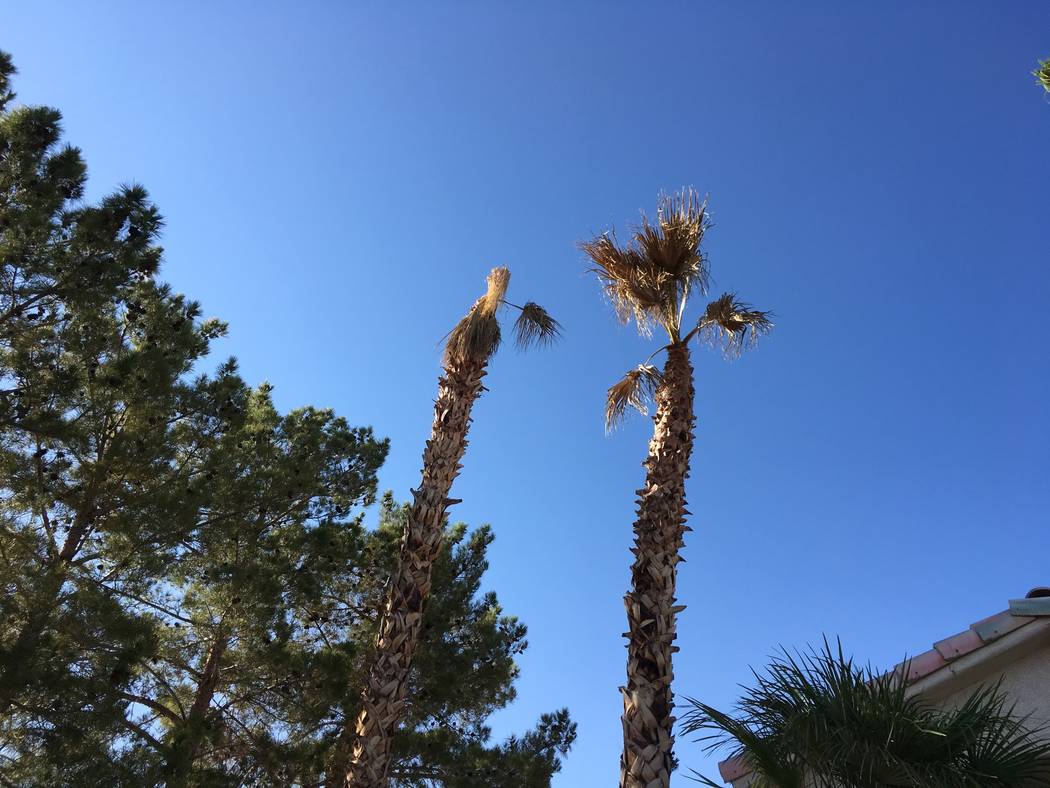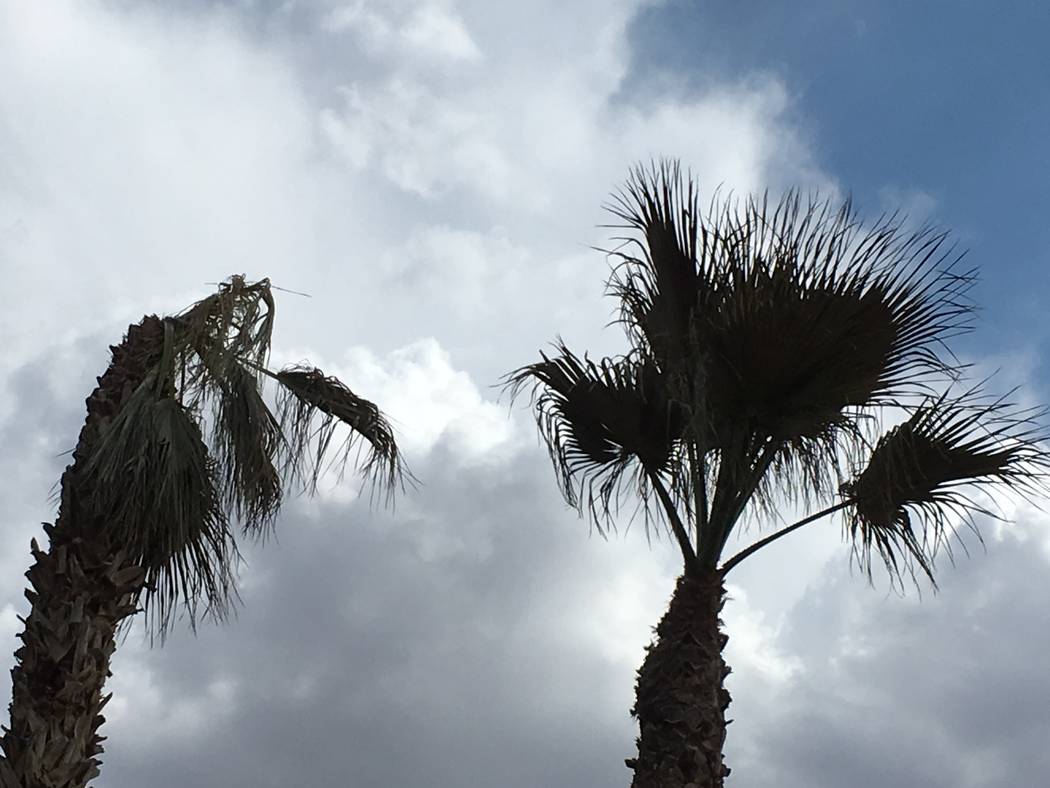Tools should always be sanitized before use on trees
Q: I have 19 mature, healthy Mexican fan palms pruned every year after flowering. This year they were pruned on June 13, but after three weeks one suddenly died and another died two weeks later. I used the same pruning crew for five years with no problems. I removed about 250 square feet of turf from in front of the trees last year with no other significant changes to their irrigation or fertilization regimen.
A: They died because the central bud at the top of the tree died. I can’t tell you exactly the reason why they died without climbing to the top, but I can give you some possibilities. Perhaps you can sort it out from there.
I don’t think this is an irrigation issue because it happened too rapidly. It is most likely a disease problem. I would guess it is either from using unsanitary pruning tools or too many palm fronds were removed.
Pruning tools must be sanitized to prevent the transmission of disease from one tree to another. Diseases are passed from tree to tree or even limb to limb by using unsanitary tools.
At a bare minimum, pruning tools should be sanitized between job sites. Ideally, they should be sanitized between trees, particularly when pruning sick trees.
I like to ask, “Would you let a doctor use a needle or scalpel just used on another patient?” Pruning plants is similar. Disease transmission is less likely between plants that are not similar but when plants are similar — all palms, for instance — more care should be used.
Sanitation of pruning tools can be simple: Wipe the tools clean and apply alcohol or Pine Sol or even heat the blade with a butane lighter.
The second possibility is damage to the central bud by removing too many fronds protecting it. The central bud of a palm tree is located at the very top of the trunk. It is surrounded by palm fronds that emerged from the bud earlier in the season.
The newest fronds are clustered around the bud while older fronds are lower and removed as they become brown or drop below horizontal. Older fronds provide no protection to the bud. Horticulturists all agree that excessive removal of palm fronds can lead to palm problems.
Excessive removal occurs when fronds are removed that previously played a role in shading it from intense sunlight or protection from other types of damage. If too many fronds are removed, protection of the bud is jeopardized.
How many should remain after pruning? Enough to protect the bud and provide energy through the leaves for vigorous new growth. Remaining fronds should occupy an upside down half-circle or 180 degrees.
Q: What should I do now with my damaged 14-year-old African sumac? I think it had borers as you mentioned in a previous column, but the treetop is lush and green and showing no dieback of the limbs.
A: Many older trees damaged by borers show only subtle, outward signs of damage. Early borer damage is difficult to see. It isn’t until the damage is extensive, usually from attacks every year, that it becomes obvious to the casual observer because of limb dieback.
I can see in the picture you sent that the borer damage to the trunk is healing. Encourage this type of healing with regular watering coupled with fertilizer applications twice a year. If it hasn’t been fertilized during the past 12 months, make an application when temperatures cool off a bit.
The best time to see hidden damage in the spring done by borers is immediately after a good rain. Damage to trees due to borers is expressed through the wet trunk or limbs as a reddish, jellylike ooze. If not seen right away, this jelly dries in a day or two leaving reddish crystals behind.
It looks like a limb broke and ripped the trunk, perhaps as it fell. This could have been because of previous borer problems that weakened the tree at this location. The central core of all trees is dead and surrounded by a cylinder of living tissue that can heal these types of wounds.
This living cylinder can be thick or thin depending on tree health. When trees are healthy and vigorous, this living cylinder repairs damage quickly by rolling over damaged areas. Large areas can heal over in a couple seasons of growth if the tree is healthy.
Q: What is causing the “big hurt” on mulberry trees? There was considerable damage to most trees in recent years. What caused so many dead branches this and last year?
A: Mulberries are solid performers in the hot desert if they get enough water and are pruned properly. I am not endorsing their planting; they use a lot of water and the male trees release large amounts of allergenic pollen — a huge health problem for many residents.
The female trees are not outlawed in Southern Nevada. The male, or fruitless mulberries, are. Female trees can be planted and will produce fruit without male trees because of the large amounts of airborne pollen produced every year from existing male trees.
We see an increasing number of mulberries with dead branches in the tops of the trees. Most of this is sooty canker disease. This fungal disease spreads from tree to tree on poorly sanitized pruning equipment, birds and insects.
It also infects other trees beside mulberry, including ash, poplar, apple and many others. Frequently, the health of infected trees was compromised in some way making them susceptible to an otherwise weak pathogen.
What compromises the immunity of otherwise vigorous trees growing in the desert? Usually, it’s the lack of water causing the trees to be stressed. The disease organism is transported to this weakened tree on pruning tools, or perhaps by birds or insects. This pathogen enters the tree through open wounds caused by pruning equipment, fresh openings left by dropping leaves or through the flowers.
Consider this scenario: A landscape converts from large, established trees and lawns to a desert landscape. The lawn is removed and drip irrigation is installed. Large established trees do not get enough water and limbs begin dying. Landscapers remove limbs with unsanitary tools. The trees become infected, and disease spreads because the tree’s health is compromised due to a lack of water.
Simple solution? Sanitize pruning equipment.
Bob Morris is a horticulture expert and professor emeritus of the University of Nevada, Las Vegas. Visit his blog at xtremehorticulture.blogspot.com. Send questions to Extremehort@aol.com.
























